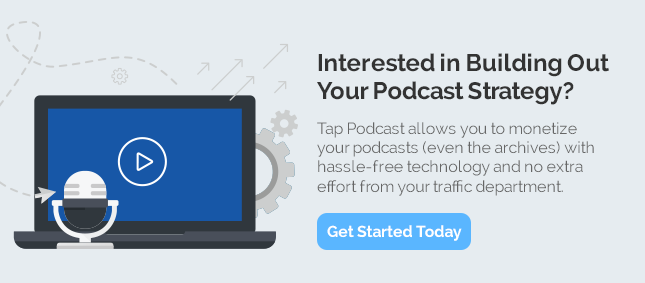Podcasting 101

The Evolution of Media
Over the past 50 plus years, technology has changed how and where we consume media. We have gone from being locked in the home with radio and TV to having content mobile and easily accessible wherever we are and whenever we want. Technology has also changed the content available to us. The introduction of FM radio gave way to diversified music formats like Album Rock, Urban Contemporary, and Oldies, and later Alternative Rock, Hip Hop, Classic Hits, and list of others. The evolution of Cable TV provided for niche channels such as the Food Network and The Weather Channel.
Today, the likes of Pandora and Spotify have forever changed the way consumers listen to music - the same way You Tube and Netflix have forever changed the way we “watch TV”. There is no limit to how niched content can get, and as consumers, we again get what we want, when we want it.
There is a plethora of it all. Every media need of every person has forever been fulfilled. Or has it?
Enter On Demand Audio
Audio and Radio have always been a consumer’s best companion. Whether on FM in the car, the Walkman, the iPod, or today’s internet radio, you can take your music with you – in the car, on the subway, while riding a horse, a bike, casually taking a walk, or training for a marathon. It’s difficult to read text or watch video while doing most of the above!
Audio is of course more than just music. Spoken word content informs, entertains, and stimulates our passions. Where “spoken word” was once just “News/Talk”, the radio dial now provides several niches, including All News, Political Talk, Sports Talk, Business Talk, and Religious Talk. Indeed, this content serves the need of many. But not all.
And so this is where “Podcasts” come in.
Pod - a detachable or self-contained unit. Cast – as in broadcast.
Podcasts are indeed “self-contained units of audio that are broadcast” to consumers. The origin of podcasts is indeed a byproduct of technological capability and new, more niche content, available to listen to when and where we want.
Podcasts have been around for more than a decade but only in the past couple years have they come to prominence. Consumers have been pre-occupied with their new smartphones, watching video and listening to music. There simply hadn’t been enough relevant content to take consumers away from their easy access and passion for music and video.
The Explosion of Podcasts
Rap had Grand Master Flash, Country had Garth, and Podcasts had Serial. Phenomenons that put certain content types on the map. Content is king. Regardless of the medium. Quality content gets people talking and Serial forever changed this on-demand audio medium. The phenomenon did two things:
-
It made consumers explore to discover other good “on-demand audio” content.
-
Publishers of all types started thinking about “on-demand audio” in a different way and realized this was a means to create new and compelling content, and a new revenue channel.
Digital Audio PS, that’s Post Serial, has generated an enormous amount of discussion from those creating the content, and indeed we see so much more on-demand audio content now available. The prevalence of podcasting has become so great that the discussion has now logically moved to “monetization”.
Show Me The Money
To date, most Podcast monetization has occurred through the very non-technical means of sponsorships. Similar to “live reads” on-air, the podcast host will often read sponsorship announcements in the actual production of the podcast itself. In other words, the “ad” is part of the content.
This works quite well and will likely continue to be an important element of podcast monetization. Advertisers value “native” ads, particularly those created by popular personalities or content topic experts. Think about your friend who is a car expert telling you he recommends Valvoline. Chances are you buy it; he’s your friend, you trust him, and he is an automotive expert. Now, think about the host of an automotive podcast, providing an implied endorsement for Valvoline Oil. Same concept and why marketers love this kind of advertising.
That said, sponsorships alone will not drive enough revenue for the segment, especially for podcasters with limited audience scale. Today, the technology exists for ads to be dynamically stitched into a podcast in milliseconds while the consumer downloads it. This means advertising does not need to be baked into the content during production. More importantly, it means opening up new revenue channels for this content.
Money! Right?
Reality and Strategy
No good opportunity comes without its challenges.
First among them is the fact that “podcasts” are often listened to offline. This is not true because it’s necessarily what consumers want, but rather what they have been trained to do. Most podcasts have historically been made available on iTunes because of it’s reach potential. Despite its value, iTunes does have limitations; audience impressions can’t be validated post-download and there is no way for the publisher to know anything about the audience. In particular, the inability to validate that an ad was actually heard – an impression delivered – the way it can with live streaming is a major hindrance to monetizing existing audiences in the space.
Those publishers that have significant scale are selling the medium based on downloads as an implied reach potential. This has become a legitimate way of selling the medium – IF the download numbers are large and the content compelling. However, in order to open the revenue channel for all podcasters, regardless of size, impression verification will become necessary.
There may be technical ways for this to be managed in the future but until something exists, podcast publishers must consider this current reality and implement the right strategy to optimize revenue opportunities.
Remember, podcasting began at a time before there was online ubiquity. Consumers originally downloaded podcasts the way they downloaded songs, and this was because the listening took place offline. Remember that old fashioned media player called the iPod? Platforms like YouTube and Spotify exploded because the content they distribute is consumed online and on-demand. The same should be true for “podcasting”. There is less of a need to download content when you can listen online and on-demand, and when you do, measuring delivered impressions is an immediate capability.
Audio content has greater viability and revenue potential when it is streamed “on-demand” rather than downloaded. Further, if this listening happens on a player equipped to gather listener data, the value of the audience becomes far greater to advertisers.
Audience Migration
Consumers form habits. They go with what they know. Moving an audience from consuming content on iTunes or other distribution points to one where the publisher has a better business opportunity is not at all easy. So what do you do?
Each publisher strategy will be different based on its own situation. However, there are a number of common denominators to consider for all of them.
-
Don’t expect moving your audience to be simple or quick. It WILL take time.
-
Though it will take time, remember, there is audience value in the current distribution ecosystem. Downloads are perfectly fine. It is just far greater when you can “stream content” and equip players with technology to learn more about the audience.
-
Though you will not stop delivering your content through current channels, realize that listeners will seek out content that is relevant, interesting and desirable. Said differently, make sure your content is relevant, interesting and desirable.
-
Begin taking steps today that will inevitably make your content more valuable:
-
Distribution Partners. Talk to them about not only making your content available through downloads but also streamed on-demand. Additionally, discuss setting up the distribution player to collect data about the consumers.
-
Self-Distribution. In addition to your current distribution be sure that content is available to be streamed on-demand and set up to expose consumer data inside your own players.
-
-
Promote your alternative distribution points (with revenue potential) within the downloaded podcasts to drive listeners to them.
-
Require registration/log in for content access on your players. Zip, Age and Gender (ZAG) will immediately create greater value of the audience
-
Where there is a registered audience, membership should have its privileges:
-
Better audio quality than other distribution points.
-
Content extras not available elsewhere.
-
Lower commercial load in content vs. “downloaded podcasts” – low cpm and high units in downloads; high cpm and low units in streamed on demand content.
-
-
Prompt, or even incentivize, your listeners to promote your player and its benefits in their own social networks.
The Final Word
It doesn’t matter whether you call it podcasting or On-Demand Audio, the opportunity is creating relevant content and delivering that content in a manner that optimizes its value to advertisers.
If you are interested in learning more about how Triton Digital can help you with your podcast strategy, contact us by clicking on the link below.
About the Author
 Dominick Milano has been a partner in Triton Digital since its inception. Milano has spent the last decade evangelizing the need for local media's digital transformation and helping clients make that transition utilizing Triton's products and services. He has spent more than 30 years in the media industry, having previously served in an array of senior management positions at the Katz Media Group, Clear Channel, and Interep National Radio Sales. A graduate of New York University, Milano resides in New Jersey with his wife and three children.
Dominick Milano has been a partner in Triton Digital since its inception. Milano has spent the last decade evangelizing the need for local media's digital transformation and helping clients make that transition utilizing Triton's products and services. He has spent more than 30 years in the media industry, having previously served in an array of senior management positions at the Katz Media Group, Clear Channel, and Interep National Radio Sales. A graduate of New York University, Milano resides in New Jersey with his wife and three children.
